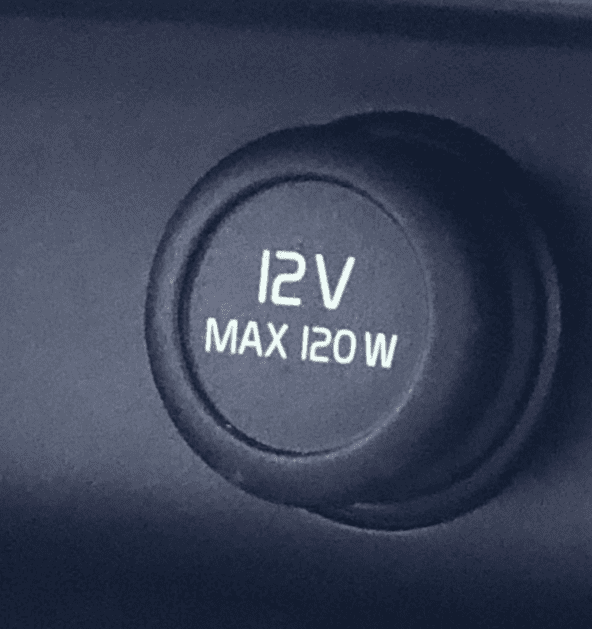The cigarette lighter port in a car is officially called an automobile auxiliary power outlet. This 12-volt DC power source is found in most vehicles. It provides a convenient way to power various devices while on the road.
The port got its name from its original purpose – lighting cigarettes. Today, it serves a much broader function. Drivers use it to charge phones, run GPS units, and power other small electronics.
Many modern cars now include USB ports alongside the traditional 12V outlet. Both serve similar purposes. But the 12V outlet can handle higher power devices that USB can’t support.
| Feature | 12V Outlet | USB Port |
|---|---|---|
| Voltage | 12V DC | 5V DC |
| Max Power | ~180W | ~10W |
| Common Uses | Phone chargers, GPS, dash cams | Phone charging, small devices |
The 12V Port: Powering More Than Just Lighters
The 12V port, often called the cigarette lighter port, is a standard feature in most vehicles. While it was originally designed to power cigarette lighters, it has evolved into a versatile power source for a wide range of devices.
Powering Essential and Convenient Devices
The 12V port provides a convenient way to power various devices in your car, including:
- Phone chargers: Keep your phone charged on the go.
- GPS devices: Navigate with ease using a dedicated GPS device.
- Dashcams: Record your journeys for safety and security.
- Portable tire inflators: Inflate flat tires without needing an external power source.
- Portable refrigerators: Keep food and drinks cool during road trips.
- In-car entertainment: Power portable DVD players or game consoles.
Understanding the Limitations
While the 12V port is versatile, it’s important to understand its limitations:
- Power output: The 12V port typically has a limited power output, usually around 10-15 amps. This means it may not be suitable for powering high-wattage devices like laptops or hairdryers.
- Overloading: Connecting too many devices or devices that draw too much power can overload the circuit and potentially damage the fuse or the devices themselves.
- Battery drain: Using the 12V port while the engine is off can drain your car’s battery.
Safety Precautions
When using the 12V port, keep these safety tips in mind:
- Use compatible devices: Only use devices designed for 12V power.
- Don’t overload the circuit: Be mindful of the power draw of the devices you connect.
- Unplug devices when not in use: This helps prevent battery drain and potential damage.
- Keep the port clean: Dust and debris can accumulate in the port, potentially causing connection issues.
Table: Devices Commonly Powered by the 12V Port
| Device | Typical Power Draw | Notes |
|---|---|---|
| Phone charger | 1-2 amps | |
| GPS device | 1-2 amps | |
| Dashcam | 1-3 amps | |
| Portable tire inflator | 10-15 amps | May require a higher-amperage port |
| Portable refrigerator | 5-10 amps |
The Evolution of In-Car Power
As technology advances, the way we power devices in our cars is changing. Here are some newer options you might find in modern vehicles:
- USB ports: Many newer cars have USB ports that can charge phones and other devices more efficiently.
- AC outlets: Some vehicles offer AC outlets that can power laptops and other high-wattage devices.
- Wireless charging: Wireless charging pads are becoming increasingly common, allowing you to charge compatible phones without any cables.
- In-car Wi-Fi: Some cars have built-in Wi-Fi hotspots, providing internet access for passengers.
These advancements offer more options and convenience for powering your devices on the go. However, the 12V port remains a reliable and versatile power source for many essential and convenient devices.
History and Evolution
The cigarette lighter port in cars has undergone significant changes since its inception. This once-standard feature evolved from a smoking accessory to a versatile power outlet for modern devices.
Origin of the Cigarette Lighter
The car cigarette lighter was invented in the 1920s as a convenient way for drivers to light cigars and cigarettes while on the road. It quickly became a standard feature in most vehicles. The original design used a coil that would glow red hot when pushed in and activated.
Early versions were simple push-button mechanisms. As technology advanced, safer and more reliable designs emerged. By the mid-20th century, nearly every car came equipped with a cigarette lighter as a standard feature.
Transition to Power Outlet
In the late 20th century, the cigarette lighter port began its transformation into a power outlet. This change was driven by declining smoking rates and the rise of portable electronics. Car manufacturers started to include the socket without the heating element.
The 12V socket became a standard power source for various devices. It could charge phones, power GPS units, and run other small appliances. This transition made the port more versatile and useful for non-smokers.
Today, many cars feature multiple 12V outlets. Some vehicles have replaced these with USB ports. The cigarette lighter receptacle remains common due to its backward compatibility with older devices.
| Decade | Primary Function | Common Name |
|---|---|---|
| 1920s-1980s | Lighting cigarettes | Cigarette lighter |
| 1990s-2000s | Dual-use (lighter/power) | 12V socket |
| 2010s-Present | Power outlet | Auxiliary power outlet |
Design and Functionality
The cigarette lighter port in cars features a simple yet effective design. It combines electrical components to provide power for various devices through a standardized connection.
Components and Structure
The cigarette lighter socket consists of a cylindrical metal housing with a spring-loaded positive contact at the bottom. A negative contact ring sits at the top of the socket. The socket typically measures 21 mm in diameter and 23 mm in depth.
Most modern vehicles include a plastic cap to protect the socket when not in use. This cap also prevents debris from entering the port and causing short circuits.
The original lighter insert had a bi-metallic strip that would heat up and glow red when pushed in. Today, many cars omit the actual lighter insert and only provide the power outlet.
The Electrical Connection
The cigarette lighter port provides 12-volt DC power from the car’s electrical system. It connects directly to the vehicle’s battery through a fuse for safety.
When a device is plugged in, it completes the circuit between the positive and negative contacts. This allows power to flow to the connected device.
Most ports can supply up to 10-15 amperes of current. This is sufficient for charging phones and powering small electronics. However, it may not be enough for high-power devices like air compressors.
| Component | Function |
|---|---|
| Metal housing | Provides structure and negative terminal |
| Center pin | Positive terminal |
| Fuse | Protects car’s electrical system |
| Plastic cap | Keeps out debris when not in use |
The standardized design allows for widespread compatibility with various car chargers and accessories across different vehicle makes and models.
Common Uses and Compatibility
The cigarette lighter port in cars offers versatile functionality beyond its original purpose. It serves as a power source for various electronic devices and portable accessories.
Charging Electronic Devices
The cigarette lighter port provides a convenient way to charge smartphones, tablets, and other gadgets while on the road. Most cars offer a 12V output through this socket, which is compatible with many charging adapters. USB cigarette lighter adapters convert this voltage to the standard 5V required by USB devices.
These adapters often feature multiple USB ports, allowing passengers to charge several devices simultaneously. This capability is especially useful during long trips or for families with multiple devices.
Some newer vehicles have replaced the traditional cigarette lighter port with dedicated USB ports. However, many still include the standard 12V socket for backward compatibility with older accessories.
Support for Portable Accessories
The cigarette lighter port supports a wide range of portable accessories designed for in-car use. These include:
- GPS navigation units
- Dash cams
- Portable coolers
- Air compressors for tire inflation
- Vacuum cleaners for car interiors
Some accessories plug directly into the port, while others use adapters. Power inverters are popular additions that convert the 12V DC power to 110V AC. This allows the use of household appliances in the vehicle.
| Accessory Type | Power Requirements | Common Uses |
|---|---|---|
| USB Adapters | 5V output | Charging phones, tablets |
| Power Inverters | 110V AC output | Laptops, small appliances |
| Cooling Fans | 12V direct | Passenger comfort |
| GPS Units | 5V or 12V | Navigation |
The versatility of the cigarette lighter port makes it a valuable feature in modern vehicles. It supports a wide range of devices and enhances the driving experience for many users.
Adaptations and Enhancements
The cigarette lighter port in cars has evolved to meet modern needs. It now serves as a versatile power source for various devices and accessories.
From Lighters to USB Ports
The traditional cigarette lighter socket has transformed into a multi-purpose power outlet. Many vehicles now feature USB ports alongside or in place of the 12V socket. These USB ports provide direct charging for smartphones, tablets, and other USB-powered devices.
USB ports offer several advantages:
- Higher charging efficiency
- Compatibility with most modern devices
- Compact size allows for multiple ports
Some cars include both 12V sockets and USB ports to accommodate a wide range of portable electronics. This dual setup ensures drivers can power both older 12V accessories and newer USB devices.
Integration of Power Inverters
Power inverters have become a popular enhancement for car power systems. These devices convert the car’s 12V DC power to 110V AC, similar to household outlets. This allows drivers to use standard electrical appliances in their vehicles.
Common uses for car power inverters include:
- Laptop charging
- Powering small appliances
- Running work tools
| Inverter Type | Power Output | Typical Uses |
|---|---|---|
| Low-power | 100-300W | Phone/laptop charging |
| Mid-range | 300-1000W | Small appliances |
| High-power | 1000W+ | Power tools, TVs |
Proper installation is crucial for safety. Many drivers opt for professional installation to ensure the inverter is correctly wired to the car’s electrical system.
Frequently Asked Questions
The auxiliary power outlet in vehicles serves various purposes beyond lighting cigarettes. Users can power devices, replace faulty outlets, and understand potential issues with these versatile ports.
What is the function of an auxiliary power outlet in a vehicle?
An auxiliary power outlet provides 12-volt DC power for various devices. It allows drivers to charge mobile phones, tablets, and GPS units while on the road. The outlet connects to the car’s electrical system.
How can you replace an automobile auxiliary power outlet?
Replacing an auxiliary power outlet involves a few steps. First, disconnect the car battery. Then remove the old outlet. Install the new outlet and reconnect the wiring. Finally, test the new outlet to ensure proper function.
What are the uses for a car cigarette lighter socket besides lighting cigarettes?
The cigarette lighter socket has many uses. It can power dash cams, portable coolers, and air compressors. Some drivers use it to charge laptops or run small appliances with the right adapter.
Can the car cigarette lighter socket be used as a reliable power outlet?
Yes, the cigarette lighter socket is a reliable power source. It provides a consistent 12-volt DC power supply for most devices. However, users should check their device’s power requirements to avoid overloading the circuit.
Why might the auxiliary power outlet in a vehicle stop functioning?
An auxiliary power outlet may stop working due to a blown fuse. Corrosion on the contacts can also cause issues. Sometimes, debris in the socket prevents proper connection. Regular cleaning and fuse checks can help maintain functionality.
Are the 12V socket and the cigarette lighter socket interchangeable in vehicles?
In most modern cars, the terms are interchangeable. Both refer to the same 12-volt DC power outlet. However, some older vehicles may have dedicated cigarette lighters that are not suitable for powering other devices.
| Feature | 12V Socket | Cigarette Lighter Socket |
|---|---|---|
| Voltage | 12V DC | 12V DC |
| Primary Use | Powering devices | Originally for lighting cigarettes |
| Device Compatibility | Wide range | Wide range (in modern cars) |
| Fuse Protection | Yes | Yes |
| Heating Element | No | Some older models |





